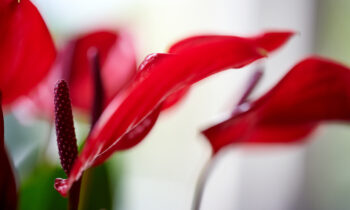The phalaenopsis is traditionally presented in a 12 cm pot (Ø). In the past few years, other pot sizes have also conquered a place in the market. For instance, a few years ago the 15 cm pot (Ø) emerged. Currently, the smaller pot sizes like the 9 cm pot (Ø) and the 6 cm pot (Ø) are on the up.
Pot size versus cultivation
The edges of the pot are often flat, in order to fit as many plants per m² as possible in the greenhouse.
The cultivation of each pot size requires a particular approach of the cultivation. Elements like market approach, cultivation period, (micro) climate, substrate and spacing each require a different strategy.
6 cm pot
Market
The market for the very smallest pot sizes is growing strongly. In countries like Germany and the Scandinavian countries, these small pot sizes have been very popular for some time now. This range is characterized by bright colours in combination with a compact plant and a compact flower stem.
Cultivation
The cultivation can take place in two ways:
1. Classically by means of a growing period and a separate cooling and finishing period.
Growing period
The plants are planted in a 6 cm pot directly from the laboratory cups and placed in trays on (roller) tables or (roller) containers. It is best to cultivate the plants in sphagnum, but with planting soil or coco peat it is also possible to obtain good results. It is important to use a substrate that is sufficiently fine because of the small plant. A too coarse substrate dries too fast, causing the small plant to dry out too quickly. The plugs are usually kept wetter than when cultivating plants in a 9 cm pot. The plants are not spaced during cultivation, because they are sufficiently compact. In the growing phase (15-18 weeks) approximately 2-4 new leaves are formed.
Cooling and finishing
The trays with the plants can be cooled without spacing. The cooling and finishing phases together last approximately 12-16 weeks.
2. Purchasing a coolable sphagnum plug of 6 cm pot.
When purchasing “half grown” plants, only the cooling and finishing phase have to be completed. Sometimes the plants are already induced and arrive “spiked”. In this case, the cultivation period is extremely short, 8-10 (spiked) to 12-16 weeks (with induction phase). It is important to keep the plug sufficiently moist for the best result as regards budding.
9 cm pot
Market
In recent years, the cultivation of the 9 cm pot has proven very profitable. It is a product that is known as compact with predominantly plants with several spikes and a lot of flowers. The range can be compared to that of small-flowered plants in a 12 cm pot, but is generally even more compact. Thanks to the rich flowering and good reputation in the sales market, there is a great demand for the products of this segment.
Cultivation
The cultivation of the 9 cm pot is characterized by the high number of plants per m². The growing period is on average some weeks shorter than the standard 12 cm pot. The growing phase lasts 20-25 weeks, the cooling and finishing together 16-17 weeks.
The production amounts to approximately 70-80 plants per m² per year. The plants start in a square layout with a density of ±120 plants per m². Normally, the plants are only spaced at the time they are cooled, especially when the total growing period is no longer than 20 weeks. The final position amounts to ±60 plants per m². Then, the plants are placed in trays at a final distance for the remaining growing period of approximately 5 weeks. The trays are necessary in order to prevent the plants on the tables from falling over.
The substrate mixture for the 9 cm pot is slightly finer than with the standard cultivation of the 12 cm pot. The mixture should minimally contain 50% bark fraction 1. A coarser mixture leads generally to a too fast drying of the substrate and this decelerates the growth of the plants and complicates sales in the chain.
This article has been prepared with the cooperation of Bureau IMAC. Anthura and Bureau IMAC cannot be held responsible for any damages, whether direct or indirect, resulting from the use of the cultivation advice given.
Optional (depending on the article)
- The grower is at all times responsible for consulting the label of crop protection products.
- The cultivation information provided is geared towards Dutch growing locations.





